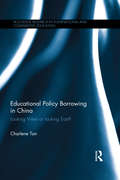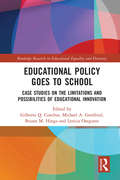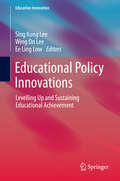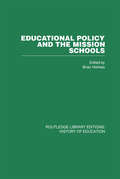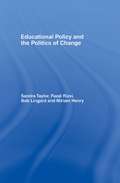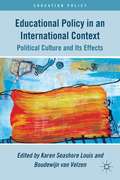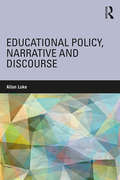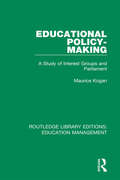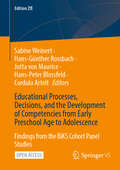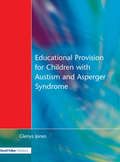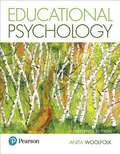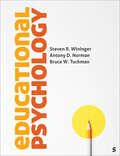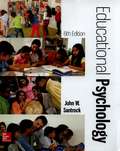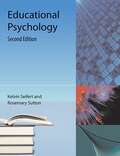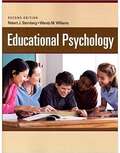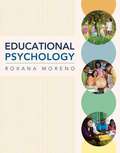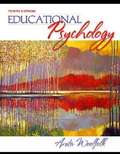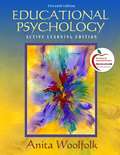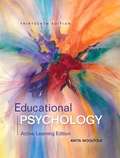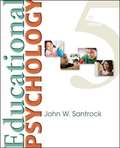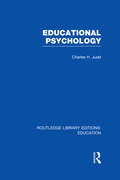- Table View
- List View
Educational Policies and Legislation in China (Zhejiang University Press Ser. #2)
by Xiaozhou Xu Weihui MeiThis book provides a comprehensive overview of the development of educational policies and legislation in China, particularly following the introduction of Reform and Opening Up in 1978. The scope of this book: (1) provides the theoretical basis and framework of educational policies; (2) explains key educational laws and legislation; and (3) introduces readers to policies for educational internationalization, private education, lifelong learning and teacher education. The book is intended for researchers, teachers and graduate students in the field of comparative education, educational policy and legislation, educational management. Readers will find essential information on the most important educational laws and legislation, as well as the recent characteristics of and trends in educational policies in China.
Educational Policy Borrowing in China: Looking West or looking East? (Routledge Research in International and Comparative Education)
by Charlene TanFor over a decade, Mainland China has been embarking on an ambitious nation-wide education reform ('New Curriculum Reform') for its basic education. The reform reflects China’s propensity to borrow selected educational policies from elsewhere, particularly North America and Europe. Chinese scholars have used a local proverb "the West wind has overpowered the East wind" to describe this phenomenon of ‘looking West’.But what do we mean by educational policy borrowing from the West? What are the educational policies in China's new curriculum reform that are perceived to be borrowed from the West? To what extent have the borrowed educational policies in China's new curriculum reform been accepted, modified, and rejected by the various educational stakeholders? How does culture influence the various educational stakeholders in China in interpreting and mediating educational policy borrowing from the West? How do the findings of this study on China’s education reform inform and add to the existing theories on and approaches to on cross-cultural educational policy borrowing? This book answers the above questions by critically discussing China’s policy borrowing from the West through its current reform for primary and secondary education. It presents the latest in-depth research findings from a three-year empirical study (2013-2015) with school principals, teachers, students and other educational stakeholders across China. This study offers new insights into China’s educational policy borrowing from the West and international implications on cross-cultural educational transfer for academics, policymakers and educators.
Educational Policy Goes to School: Case Studies on the Limitations and Possibilities of Educational Innovation (Routledge Research in Educational Equality and Diversity)
by Gilberto Q. Conchas Michael Gottfried Briana M. Hinga Leticia OsegueraEducational policies explicitly implemented in order to reduce educational gaps and promote access and success for disenfranchised youth can backfire—and often have the unintended result of widening those gaps. In this interdisciplinary collection of case studies, contributors examine cases of policy backfire, when policies don’t work, have unintended consequences, and when policies help. Although policy reform is thought of as an effective way to improve schooling structures and to diminish the achievement gap, many such attempts to reform the system do not adequately address the legacy of unequal policies and the historic and pervasive inequalities that persist in schools. Exploring the roots of school inequality and examining often-ignored negative policy outcomes, contributors illuminate the causes and consequences of poor policymaking decisions and demonstrate how policies can backfire, fail, or have unintended success.
Educational Policy Innovations
by Sing Kong Lee Wing On Lee Ee Ling LowThis volume presents how high performing education systems over the world are constantly innovating their educational policies to nurture their citizens for the challenges of the future economy and the anticipation of the unknown. This volume includes a state-of-the-art review of the literature in this field, several commissioned focal chapters focusing on the distinctive case of Singapore and internationally commissioned chapters of several other accomplished education systems around the world. A comparative study of Singapore against other high performing education systems is included to provide greater insights to the possible applications to other education systems.
Educational Policy and the Law
by Rachel Moran James E. Ryan Betsy Levin Kristi L. Bowman Mark G. YudofThis comprehensive casebook presents thorough coverage of a complex and dynamic subject--educational law and policy in the elementary and secondary school setting. With an emphasis on the interplay between law and policy, legal decisions, and educational practice, the book's interdisciplinary approach provides a wide range of perspectives on the most pressing issues in the field. Cases, legislation, and articles, all of which are accompanied by notes and discussion questions, clarify the issues and bring them to life. The book draws upon a range of social science sources as well as conventional legal materials, offering analyses that provide insights into the political and policy contexts of legal issues, and helping readers make sense of legal decisions. The abundant notes and references also make the book a useful reference work for lawyers or school administrators working in the field.
Educational Policy and the Mission Schools: Case Studies from the British Empire
by Brian HolmesOriginally published 1967, this title reveals how the missionaries, so often misguided and short-sighted, were in fact pioneers of modernization, science and freedom. The structure of the book allows for comparative analysis and the volume illustrates how some of the social consequences of action through the schools could be foreseen. In addition light is thrown on the results of Imperial rule during the nineteenth century and on the nature of the impact of Western education in Asia and Africa.
Educational Policy and the Politics of Change
by Sandra Taylor Fazal Rizvi Bob Lingard Miriam HenryGovernments around the world are trying to come to terms with new technologies, new social movements and a changing global economy. As a result, educational policy finds itself at the centre of a major political struggle between those who see it only for its instrumental outcomes and those who see its potential for human emancipation. This book is a successor to the best-selling Understanding Schooling (1988). It provides a readable account of how educational policies are developed by the state in response to broader social, cultural, economic and political changes which are taking place. It examines the way in which schools live and work with these changes, and the policies which result from them. The book examines policy making at each level, from perspectives both inside and outside the state bureaucracy. It has a particular focus on social justice. Both undergraduate and postgraduate students will find that this book enables them to understand the reasoning behind the changes they are expected to implement. It will help to prepare them to confront an uncertain educational world, whilst still retaining their enthusiasm for education.
Educational Policy in an International Context
by Karen Seashore Louis Boudewijn Van VelzenProvides a provocative examination of the interplay between political culture and educational policy. The goal is to provide a better understanding of how different countries are responding to the global exchange of policy ideas that includes 'the standards movement' and 'new public management' or accountability in the public sector.
Educational Policy, Narrative and Discourse
by Allan LukeThis collection of Allan Luke’s key writings on educational policy, curriculum, and school reform follows the development and use of critical discourse analyses to study educational policy and practice. Turning to a series of narrative analyses of the relationship between politics, culture, economics, and education, Luke‘s writings address the challenges of shifting from an academic and scientific critique of policy to ‘getting your hands dirty’ in the making of state educational policy. The volume includes international examples of policy formation for social justice and equity, and closes with an auto-ethnographic view on policymaking and the need for increased critical, sociological evidence-based educational reform. Together with its companion volume, Critical Literacy, Schooling and Social Justice: The Selected Works of Allan Luke, this collection gathers Luke’s seminal key writings spanning the fields of education, applied linguistics, sociology, and cultural studies for the benefit of scholars, students, teachers, and teacher educators around the world.
Educational Policy-making: A Study of Interest Groups and Parliament (Routledge Library Editions: Education Management)
by Maurice KoganOriginally published in 1975. This masterly study of policies and policy-makers in education opens up a major, and fascinating, area of public policy to analysis. In this book Professor Kogan draws together many of his previous findings to provide a searching examination and overview of education and its relationship both to government and to individuals and groups within the system. The result is not only a definitive statement on the making of educational policy, but a study of pressure groups; and in broader terms it is a commentary on the democratic efficiency of the British policymaking process both inside and outside Parliament. The core of the book is an analysis of the main policies which were the major concerns of educational government between 1960 and 1974. This shows how the various interest groups in education differ in their attitudes and their ways of working; and provides both an intriguing insight into the historical development of education over this key period and a variety of personal views from the individuals who helped to shape this development.
Educational Processes, Decisions, and the Development of Competencies from Early Preschool Age to Adolescence: Findings from the BiKS Cohort Panel Studies (Edition ZfE #16)
by Hans-Peter Blossfeld Jutta Von Maurice Cordula Artelt Sabine Weinert Hans-Günther RossbachThe contributions to the open access volume are comprehensive summaries of important research findings from the two comprehensive interdisciplinary longitudinal studies BiKS-3-18 and BiKS-8-18 conducted by the research unit "BiKS" (“Educational Processes, Development of Competencies, and Formation of Educational Decisions”) funded by the German Research Foundation. The aim of the book is to present selected important findings from these comprehensive longitudinal educational studies; in addition, the edition also aims to provide an overview of the design and measurements of the two surveys.
Educational Progressivism, Cultural Encounters and Reform in Japan (Progressive Education)
by Yoko Yamasaki Hiroyuki KunoEducational Progressivism, Cultural Encounters and Reform in Japan provides a critical analysis of educational initiatives, progressive ideas and developments in curriculum and pedagogy in Japan, from 1900 to the present day. Drawing on evidence of both cultural encounters and internal drivers for progressivism and reform, this book re-evaluates the history of Japanese education to help inform ongoing and future debates about education policy and practice worldwide. With contributions from Japanese scholars specialising in the history and philosophy of education and curriculum studies, chapters consider key collaborative improvements to teacher education, as well as group learning, ‘life education’, the creative arts and writing, and education for girls and women. The book examines Western influences, including John Dewey, Carleton Washburne and A. S. Neill, as well as Japan’s own progressive exports, such as holistic Zenjin education, Children’s Villages and Lesson Study, highlighting cultural encounters and progressive initiatives at both transnational and national levels. The chapters reflect on historical and political background, motivations, influences and the impact of Japanese progressive education. They also stimulate, through argument and critical discussion, a continuing discourse concerning principles, policy, politics and practices of education in an increasingly globalised society. A rigorous and critical study of the history of progressive education in Japan, this book will interest an international readership of academics, researchers and postgraduate students in the fields of progressive education, comparative education, social and cultural history, history of education, Japanese studies, curriculum studies, and the history of childhood.
Educational Provision for Children with Autism and Asperger Syndrome: Meeting Their Needs
by Glenys JonesThe range of educational options available to a child with Autism and Asperger syndrome is broad, but choosing the right path can often be a complex task for all involved. This book provides information and advice for professionals and parents making crucial decisions about meeting the needs of children with autistic spectrum disorder. It covers the range of intellectual ability from those having severe learning difficulties to those of above average intelligence. Practical advice for those working with children from preschool to post-16 is given on: choosing the most appropriate educational placement; making decisions on which educational interventions to follow; creating an effective educational environment; working with staff and other children to maximum effect; writing effective individual education plans; working with parents and families; enabling a smooth transition between classes and stages of education; and life beyond school.
Educational Psychology
by Anita WoolfolkEducational Psychology, 14th Edition emphasizes the educational implications and applications of research on child development, cognitive science, learning, motivation, teaching, and assessment. Theory and practice are considered together, showing how information and ideas drawn from educational psychology research can be applied to solve the everyday problems of teaching. Infused with real-world issues, lesson segments, case studies, and practical ideas from experienced teachers, Educational Psychology reflects the field and offers unique and crucial knowledge to any who dare to teach and to all who love to learn. <p><p> The 14th Edition provides cutting-edge coverage and intelligent examinations of emerging trends in the field and society that affect student learning, such as student diversity, inclusive classrooms, neuroscience, educational policy, and technology.
Educational Psychology
by Steven R. Wininger Antony D. Norman Bruce Wayne TuckmanEducational Psychology distills the latest research into actionable steps, guiding students in building solid, evidence-based teaching plans as they prepare to enter the classroom. Employing a meta-cognitive approach, it encourages them to think about their dual role as both teachers and learners, understanding not just "what" to do in the classroom, but the "why" behind it. Motivation is a central theme, with the authors providing a practical framework to help teachers enhance student motivation and connect it to key themes and concepts throughout the text. Rather than taking an encyclopedic approach, the authors group chapters by topic, enabling readers to remember concepts and connect best practices to big ideas in educational psychology. By blending scholarship with application through vignettes, examples, case studies, and practical teaching strategies, this text equips students to be both methodical and creative in their future classrooms. This text is offered in Sage Vantage, an intuitive learning platform that integrates quality Sage textbook content with assignable multimedia activities and auto-graded assessments to drive student engagement and ensure accountability. Unparalleled in its ease of use and built for dynamic teaching and learning, Vantage offers customizable LMS integration and best-in-class support. Instructors, see how Vantage works! Take a brief self-guided tour with our interactive demo
Educational Psychology
by Steven R. Wininger Antony D. Norman Bruce Wayne TuckmanEducational Psychology distills the latest research into actionable steps, guiding students in building solid, evidence-based teaching plans as they prepare to enter the classroom. Employing a meta-cognitive approach, it encourages them to think about their dual role as both teachers and learners, understanding not just "what" to do in the classroom, but the "why" behind it. Motivation is a central theme, with the authors providing a practical framework to help teachers enhance student motivation and connect it to key themes and concepts throughout the text. Rather than taking an encyclopedic approach, the authors group chapters by topic, enabling readers to remember concepts and connect best practices to big ideas in educational psychology. By blending scholarship with application through vignettes, examples, case studies, and practical teaching strategies, this text equips students to be both methodical and creative in their future classrooms.
Educational Psychology
by John SantrockSantrock’s Educational Psychology emphasizes the application of theory to real classroom practice. With richly evocative classroom vignettes from practicing teachers and a wealth of case studies, Educational Psychology helps students think critically about the research basis for best practices. Santrock’s hallmark Learning System organizes the content into manageable chunks under learning goals, supporting retention and mastery, so that students will have an engaging and successful course experience. The Connect course for this offering includes SmartBook, an adaptive reading and study experience which guides students to master, recall, and apply key concepts while providing automatically-graded assessments.
Educational Psychology
by Kelvin Seifert Rosemary SuttonContents: 1) The Changing Teaching Profession and You. 2) The Learning Process. 3) Student Development. 4) Student Diversity. 5) Students with Special Educational Needs. 6) Student Motivation. 7) Classroom Management and the Learning Environment. 8) Instructional Strategies. 9) Planning Instruction. 10) Teacher-Made Assessment Strategies. 11) Standardized and Other Formal Assessments. 12) The Nature of Classroom Communication. 13) The Reflective Practitioner.
Educational Psychology
by Wendy Williams Robert SternbergWritten to help readers understand and develop expertise in both teaching and learning, Educational Psychology focuses on the art and science necessary to become an expert teacher. <p><p> Renowned scholars, Sternberg and Williams help readers capitalize on their strengths by integrating questions into the text that encourage analytical, creative, and practical thinking. This framework, based on Sternberg’s triarchic theory of human intelligence, helps ensure that readers think deeply about what they are learning, rather than merely processing information at a superficial level.
Educational Psychology
by Roxana MorenoEducational Psychology First Edition will help students meet the challenges of today's classrooms. Future teachers want practical suggestions for why and how to use theory in the classroom. To support their preparation, this textbook emphasizes three challenges in teacher education: understanding and addressing the needs of the diversity of learners in the classroom, applying theories and research to the classroom, and critically examining teaching practices through reflection, problem-solving, and critical thinking.
Educational Psychology (10th Edition)
by Anita E. Woolfolk-HoyThis best-selling, classic text provides beginning teachers with the tools and inspiration to become masters of their chosen profession. The Tenth Edition maintains the lucid writing style for which the author is renowned, combined with a clear emphasis on educational psychology's practical relevance. This edition provides especially helpful new chapter on Engaged Learning: Cooperation and Community, recognizing the challenges educators face in the next decade to keep all students connected to learning and all schools safe and compassionate. The most applied text on the market, this text is replete with examples, lesson segments, case studies, and practical ideas from experienced teachers. In addition, at the end of the text is A Handbook for Successful Teaching and Lifelong Learning, which has four sections: Creating a Praxis II/Licensure Examination Study Guide Standards and Licensure Appendix: Praxis II and INTASC Getting a Job: Interview Questions that Educational Psychology will help you answer Enhancing Your Expertise: Continuing your Learning The four sections of this Handbook for Successful Teaching and Lifelong Learning will give you even more tools for passing your licensing test, getting a job, and teaching well, no matter what surprises come your way. For the first time, this text will appear in a MyLabSchool Edition, so every copy will include an access code to a special version of Allyn and Bacons hugely popular MyLabSchool, a collection of web-based resources for teacher candidates. This special site will contain the following: A rich collection of video clips showing theoretical concepts and teaching methods in practice in real classrooms. An electronic version of the text (an ebook) which contains chapter review quizzes after each section, and the capacity to generate and individualized study plan, whereby students quiz answers are graded, and they are directed to specific pages and sections in the text that will help them correct erroneous answers and master the material. A Lesson Plan/Portfolio Builder, which provides templates for lesson plans and portfolios and a database of state teaching standards that can be correlated to students work by specific state, subject area, and grade level. Access to Research Navigator, an extensive database of academic research journals and helpful advice on writing and formatting research papers Many more resources (e. g. websites, lesson plans, sample assessments) that will help pre-service teachers get ready to get certified, get their first jobs, and start their careers with many ready-to-use teaching tools.
Educational Psychology (11th Edition)
by Anita WoolfolkThe eleventh edition of the book continues to emphasize the educational implications and applications of research on child development, cognitive science, learning, teaching, and assessment.
Educational Psychology (13th Edition)
by Anita Woolfolk HoyThis edition of Woolfolk's book has been reformatted to give instructors greater course flexibility and to help students master the material even more easily. It provides state of the art information, delivered in multiple media and modalities, for students with a variety of learning styles.
Educational Psychology (5th Edition)
by John W. SantrockJohn Santrock's Educational Psychology emphasizes the application of theory to real classroom practice. With richly evocative classroom vignettes from practicing teachers and a wealth of case studies,Educational Psychology helps students think critically about the research basis for best practices. Santrock's hallmark Learning System organizes the content into manageable chunks under learning goals, supporting retention and mastery, so that students will have an engaging and successful course experience.
Educational Psychology (Routledge Library Editions: Education)
by Charles H JuddNo influence has more profoundly affected educational thought and practice during the late 19th and early 20th centuries than the science of psychology. This volume discusses the major differences between education prior to the influence of educational psychology and then examines the impact this had on the education of children and the experience of teachers.

